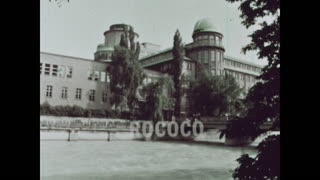This film “West Germany: Industrial Giant” dates to 1966 and was made by Centron released by the McGraw-Hill Co. Clyde F Kohn, Ph.D. served as the adviser for the film. The structure of the film is in the following segments: (1) Introduction to Carl Wilhelm and his life in Duisburg, an industrial city in West Germany. (2) Overview of West Germany’s industrial growth, including its factories, steel mills, and rail yards (3) Description of Germany’s geography, population, and division into East and West Germany. (4) Cultural and Agricultural Practices: Insights into Southern Germany’s medieval cities, agricultural practices, and small handcraft industries (5) Detailed look at various industries, including chemical, iron and steel, and automobile manufacturing (6) Importance of the Rhine River, highways, and railways for transporting goods (7) Berlin’s Significance: Description of Berlin, its division by the Berlin Wall, and its modern architecture and educational institutions.
00:00: Instructions for setting up a 16mm movie projector, including checking the focus and synchronizing sound with a visual flash.
2:02: Introduction to a boy named Carl Wilhelm, who lives in Duisburg, on the Ruhr River in West Germany, an industrial hub with factories, steel mills, and rail yards. Barges are shown moving on the river. Description of Carl’s family life, highlighting the high wages of steel workers and the modern amenities they can afford which include TV sets.
3:02: Overview of West Germany’s industrial success and the character of its people. Animation shows geographic and demographic details of Germany, emphasizing its division into East and West Germany. Germany’s diverse landscapes, from the northern plains to the Bavarian Alps.
4:47: Depiction of Southern Germany’s medieval cities, castles, and the Black Forest. Agricultural practices in the highlands, including small-scale farming of hay and dairy production. Pastoral scenes of farmhouses that combine living spaces for both families and livestock.
6:05: Introduction to small handcraft industries, such as violin making in Mittenwald. Germany’s musical heritage and the pride in craftsmanship.
7:02: Munich, its cultural sites, and its role as a center for technical skills and manufacturing.
7:31: Description of the Rhine Valley and its importance to trade and manufacturing.
8:11: Historical and economic significance of the Rhine River, including its role in the wine industry.
Overview of Bonn, the capital of West Germany, and its government institutions.
9:26: Description of the Ruhr Valley, a major industrial region with a high concentration of factories and workers.Ruhr Valley’s development, driven by water power and coal deposits. Discussion of the chemical industry and its reliance on coal, highlighting Germany’s limited natural resources.
11:58: Contributions of German scientists to chemical research and the production of various chemical products. Importance of the chemical industry to Germany’s economy and exports.
13:02: Overview of the iron and steel industry in the Ruhr Valley, including the need to import iron ore.
13:31: Description of the production of finished steel products, such as locomotives and trucks.
Role of the automobile industry in West Germany, with a focus on a plant in Bremen.
14:05: Overview of Germany’s transportation infrastructure, including highways and railways.
15:12: Importance of the Rhine River for transporting goods, with Duisburg as a key inland port.
15:12 : Description of Hamburg, its port, and its role in international trade. Germany’s need to import food due to its large population.
17:00: Agricultural practices in northern Germany, including potato farming and forestry.
17:32: Fertile soil in the central highlands and its agricultural productivity.
18:06: Industrial dominance in even the most fertile areas, with the Volkswagen plant at Wolfsburg shown as an example.
18:59: Description of Berlin, its division, and the significance of the Berlin Wall.
19:59: Overview of West Berlin’s modern architecture, educational institutions, and shopping districts. Emphasis on the prosperity and industrial strength of West Berlin and West Germany.
This film is part of the Periscope Film LLC archive, one of the largest historic military, transportation, and aviation stock footage collections in the USA. Entirely film backed, this material is available for licensing in 24p HD, 2k and 4k. For more information visit http://www.PeriscopeFilm.com


